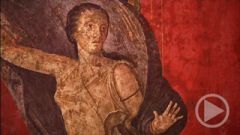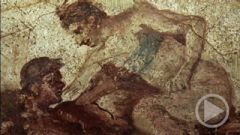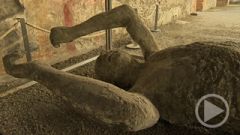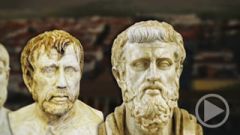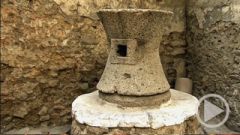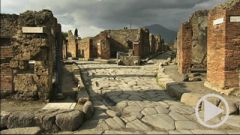Prestige Is Everything Roman Houses and Families
Prestige Is Everything
From the outside, the houses are often forbidding with their high, nearly windowless walls. But their appearance is deceiving. Even wealthy homes are not hidden away behind barriers and security fences. On the contrary: the houses are open to all. The front doors are spectacular, designed to impress. And often they stay open all day long. But here there is a guard: ‘cave canem’ – beware of the dog! This was not necessarily an empty threat. Many people in Pompeii had dogs – and some of the animals did not survive the eruption of Mt. Vesuvius.
The view from the entrance across the Atrium is carefully planned.
Prof. Karl-Wilhelm Weeber, Witten:
"It was important especially for upper-class Romans to let the public into their private rooms – part of them, at least – because they wanted to show off what they had. That is why the Atrium – and the Tablinum, the reception area – and the Peristyle, the garden, are all arranged along a line of sight. So, when the door was open, one look along the visual axis was enough to recognize the wealth that was present in the house."
That wealth was also demonstrated by the decorations of the houses. The rooms were painted from floor to ceiling with panels steeped in color. Many of these frescoes are on display today in the Archaeological Museum in Naples.
Over time the decorations became more and more fanciful. However, just like today, some people had little sympathy with modern art. The architect Vitruvius, who wrote the only surviving Roman treatise on architecture, complained about it:
"How can a reed support a roof, or a candelabra carry the ornaments of a pediment? How can a thin, delicate branch hold a seated figure, or roots and stalks produce blossoms here and half-length figures there?"
The conclusion for Vitruvius is clear:
"Pictures which are unlike reality should not be approved, and even if they are artistically fine, this is no reason why they should be judged to be correct, if they violate common sense."
But above all, Vitruvius’s work contains specific instructions on building Roman houses. The atrium is the center of the house. It provides light – and water: In the Impluvium rainwater collects from the roof. The most expensive homes in Pompeii had running water. The others captured rainwater so that residents didn’t have to keep dashing off to the nearest public fountain.
Visitors were welcome in the atriums of elegant homes – they were grand reception areas open to the public. But again, matters are not as clear-cut as we’d like them to be.
Prof. Andrew Wallace-Hadrill, Cambridge:
"We really expect rooms to have functions: this room is a dining room, this room is a bedroom, this room is a library, maybe. I’ve come to think that you have to operate with much looser categories with antiquity: that these are the reception rooms but let’s not be too fussy about it – and of course, at some times they may have used this great reception room for weaving, and therefore we find a lot of loom weights in it."
Some households used the atrium as a storeroom, and archaeologists have often found them furnished with tables or cupboards. The walls of THIS room still show the traces of shelves. The holes are where the shelf supports were embedded in the wall. It is a Cubiculum – one of the small rooms off the atrium that were also used as bedchambers.
There are more rooms on the upper floor. Most of the houses in Pompeii were two-story buildings and sometimes a flight of stairs led up directly from the atrium. Today the rooms seem empty and desolate. But when they were first excavated, they were full of objects. Most of the artefacts are now in the museum in Naples.
By today’s standards, the kitchen is very small. Here’s a surprise. The toilet was in the kitchen – so it could be used to dispose of kitchen waste as well. There was no bathroom – in the Roman world, bathing was a PUBLIC pleasure.
How many people might have lived here? The Roman ‘familia’ included not only parents and children, but slaves as well. The head of the family, the ‘pater familias’, has absolute power over the household. His wife and even his grown children remain dependents throughout his lifetime. The room most closely associated with the Pater Familias is the Tablinum – the reception room opposite the entrance. It is splendidly furnished – the floor is adorned with a costly mosaic.
An author is surrounded by his troupe of actors – archaeologists named the building “the house of the tragic poet” after this image. Like the frescoes, mosaics were art forms that the Romans adopted from Greek culture.
This famous mosaic was also discovered in a tablinum. Visitors to the room found themselves face to face with the greatest general of all time – Alexander the Great. The dramatic scene shows him in the Battle of Issus, defeating the Persian king Darius, a powerful rival in the ancient world. Apparently, the owner here in Pompeii hoped to bask in the glory of the mighty Alexander.
The tablinum was also the room where the pater familias received poorer citizens, who came to ask for assistance. He did not view them as pesky beggars.
Prof. Andrew Wallace-Hadrill:
"You can only tell that a rich person is powerful because lots of people cluster around them and ask for support. Even in the act of supporting your dependents you are translating your wealth into power. And so, in some sense, the ancient rich can’t live without the poor. The modern rich want to escape them."
Behind the tablinum: the garden. Some houses had only a tiny one – but it did provide light, air and a bit of green. And you don’t have to settle for just a few plants. Those who can afford it, open up the walls with pictures – turning even the tiniest garden into an exotic paradise with wild animals or gods.
The owner of this house probably didn’t have the money to pay for a great artist – his pretentious Venus looks a bit clumsy. But the overall effect is delightful. The picture takes us to the sea – where the goddess reclines on her half-shell. It’s a window on a faraway place - flanked by luscious gardens featuring a statue of Mars - the god of war - and a fountain.But sometimes the gardens themselves have impressive dimensions. This house belongs to one Octavius Quarto – at least his seal ring is later found at the entrance. His property in the heart of the city is designed like a country manor. The shady trees are reflected in water channels full of shimmering fish. On warm summer evenings the owner receives his dinner guests in the idyllic outdoor “Summer Triclinium” – where the diners recline around a fountain.
The more educated visitors may be amused by this ironic touch: above the water is a picture of Narcissus, the demigod who fell in love with his own mirror image in the water. Another room opening up to the garden is the Oecus – a parlor for receiving guests – which the owner has also decorated with paintings and mosaics. Those who have no Triclinium can hold banquets here.
Dinner invitations are important social occasions where rich families demonstrate their wealth to one other. Frivolous touches are very popular – like these bronze figures who probably held out snacks for the guests on their trays.
Banquets were not necessarily orgies. The evening entertainments could vary greatly, depending on the temperament of the host.
Prof. Karl-Wilhelm Weeber:
"You might have philosophical conversations – some did – or you could have a speaker who would recite Homeric verses, even an entire book of Homer – some did that – but then there were others who would hire a few female dancers and flutists and take advantage of their talents in every conceivable way."
Here, people are drinking and partying. One of the women seems to have had too much wine – fortunately, a helpful slave is at her side. The pictures were found in a large room at the back room of a bakery. The baker probably rented it out to Pompeians who lacked the space to hold a banquet. Usually these kinds of parties were reserved for the rich.
One of the largest houses belongs to the Poppaei, who were among the richest families of the entire empire. A daughter of the family was the second wife of Emperor Nero. She became a star in the capital, famed for her beauty, notorious for her ambition. Here excavators discovered a set of silverware carefully packed in a wooden chest, along with the family jewels. These exquisite furnishings belonged to wealthy households. Ordinary people made do with tableware made of bronze, clay or cheap glass.
Obviously, not all Pompeians lived in luxury. Many of the craftsmen and merchants were former slaves. They often lived behind or over their workplaces – in small rooms with no space for a kitchen. Nowadays, rich people eat in restaurants, while the poor cook at home. In the Roman Empire it was the other way round. Throughout the town we find the typical cook-shops where ordinary people went to eat. Many of them were also grocery stores. The groceries were kept in the clay vessels – and hot dishes could be prepared right there at the counter.
Recent research shows that even the less wealthy people of Pompeii and Herculaneum ate well. Professor Andrew Wallace-Hadrill found evidence for this in a sewer, of all places.
Prof. Andrew Wallace-Hadrill:
"Now, that sewer is under a block of houses which are shops and flats. There’s no way that the people who live there were the elite, the rich people of town. And yet their diet is wonderfully rich and varied: there’s fish and nuts and meat and fruit and eggs and chickens and sea urchins – all sorts of stuff. And it tells you that the ordinary people lived in a way that if all the evidence you had was the contents of what they were eating, you’d say: oh, these must be rich people!"
It is also impossible to distinguish rich and poor by the section of town they lived in. Pompeii had neither affluent areas nor slums. Residents from all social classes lived side by side – like here in the block of houses known as the Insula Arriana Polliana. The inside of the block is taken up by a luxurious dwelling known as the House of Pansa. Around it were simpler apartments, smaller atrium houses of the type called “domus” – rather like today’s single-family homes. On the exterior, facing the main street were shops, some of them with mezzanines. On the side alleys were tiny shops, generally with just one or two rooms. We don’t know what goods they sold, but some of the vendors in these stalls must have slept behind their counters.
The upper floors of the houses often contained rental apartments. Few of them have been preserved – generally we can only see the entranceways. They are found throughout the city – in some cases, the stairways are still standing.
Rented apartments are not necessarily living quarters of poor residents – as advertisements on the facades tell us:
“In the property of Julia, daughter of Spurius Felix, to let: elegant bathing facilities for respectable people, shops with annexed apartments upstairs and independent apartments on the first floor for a period of five years from this coming August to August 1st of the sixth year.”
Prof. Andrew Wallace-Hadrill:
“Judging from Pompeii alone it would be easy to imagine that the rich people lived on the ground floors and their slaves lived in attics upstairs but in Herculaneum you see that the decoration in the upper floors is also very fine, that there isn’t the distinction in levels between the slave and owner; that people lived in flats on upper floors that could be really rather smart.”


